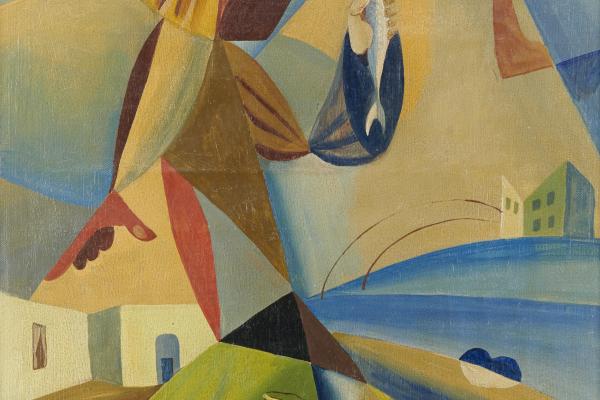Press article : The return of the woman ! La Gazette Drouot
The return of the woman ! La Gazette Drouot
- 7/5/24
- Paintings

La Marchande de poissons, 1933
Blue, yellow, white and green dance in ellipsis to build this composition inhabited by truncated elements that have the force of symbols. The artist's aim was to evoke the figure of "The Fishmonger", with the blue of the sea here, the white walls of the Catalan houses there, two wings recalling the appetite of the seagulls there, and a yellow circle to signify that this land belongs to the sun. His portrait by Modigliani, beyond the characteristic elongation given to his models by the Montparnasse painter, shows an elegant man with a fine moustache but above all with penetrating eyes of a translucent blue.
Léopold Survage (1879-1968), "La Marchande de poissons",1933, oil on canvas, 56 x 36 cm - Estimate : 25000/30000€
Léopold Frédéric Stürzwage, known by his French name, Léopold Survage, took a singular look at the art of his century, influenced by both cubism and surrealism, borrowing from both abstraction and figuration. Nourished by a variety of references, drawn from the legends of his youth and the Russian avant-garde movements, and thirsty for modernity and artistic effervescence, he was barely able, when he moved to Paris in 1909, to work on and present his "Coloured Rhythms" series at the 1912 Salon des Indépendants. His constant need for movement quickly made him bored, even in Matisse's studio, which he had dreamed of joining. It was then that he realised that the only possible path for him would be his own. The 14-18 war took him as far as Nice, where he was reunited with many of his compatriots.
The discovery of Mediterranean light was a shock, and he opened his palette to pastel shades and began to offer paintings of a new kind, which he described as "a plastic synthesis of space". The canvas is cut into various elements that are superimposed and change function. A leaf is enough to represent a tree, and a door suggests a house. Then it was Collioure on several occasions between the end of the 1920s and the beginning of the following decade, the town that had already so seduced Derain, Martin, Signac and, of course, Matisse. Always quick to reinvent himself, he reintroduced the human figure into his paintings, especially the woman, who would henceforth occupy a central place. He depicted women in their various everyday tasks and occupations.
This "Marchande de poissons " from 1933 is a perfect example of her work at the time. Returning to the sea where she was born, she will be fishing in Cannes in the middle of summer!
AUGUST THURSDAY 15TH. CANNES. BESCH CANNES AUCTION OVV
LA GAZETTE DROUOT N° 27 OF JULY 05TH, 2024, BY ANNE DORIDOU-HEIM

